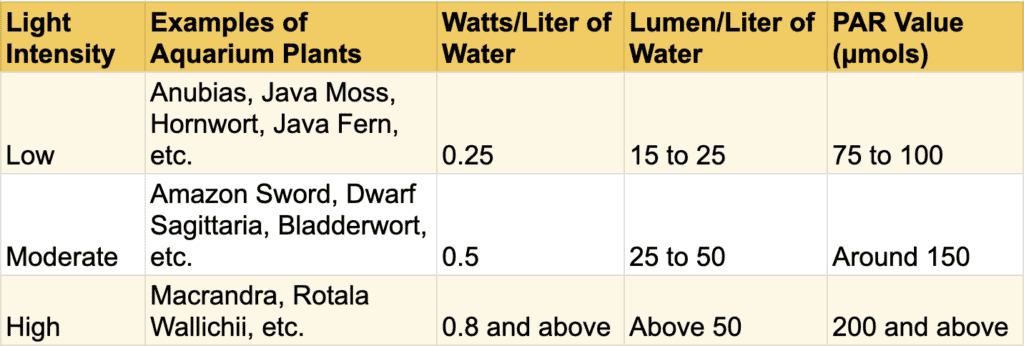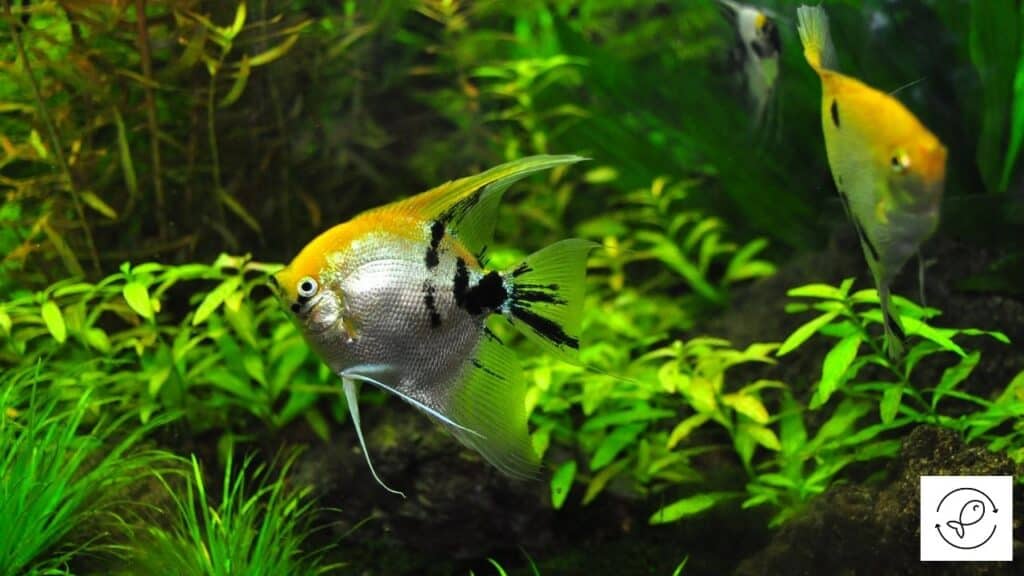Aquarium lights can be used to grow plants as long as the light intensity is adequate. Aquarium plants use all color spectrum except green for photosynthesis. However, a mix of red and blue light is considered best for plants. Of all the light sources, LED lights are the best for plant growth.
Let’s talk about this in more detail now.
5 Reasons Why Aquarium Plants Need Light
Light plays an important role along with nutrients in the healthy growth of aquarium plants.
It’s life for aquatic plants. Without adequate aquarium lighting, aquarium plants can’t grow fully and be healthy.
Aquarium plants need light for the following reasons:
- Light is necessary for photosynthesis. Without photosynthesis, plants can’t grow properly and will perish.
- Adequate lighting enables the aquarium plants to absorb the carbon dioxide that the fish breathe out. Carbon dioxide is essential for plants to make the sugars that they need to thrive. In the process, they release oxygen.
- Proper lighting helps grow healthy and lush plants as well as control algae growth.
- Plants that don’t get adequate light become weak and start dropping their leaves, especially the older ones.
- Lack of adequate lighting results in aquarium plants turning pale green to yellow to white. This happens because plants can’t produce chlorophyll due to insufficient lighting.
What Color Light Do Aquarium Plants Need?
Aquarium plants use all colors of the spectrum, except green, for photosynthesis. The green light has minimal effect on plants. However, it’s more beneficial for our vision.
A red and blue spectrum light is the best for aquarium plants as it stimulates pigmentation in plants.
Thereby red and blue lights stimulate coloration.
So, the goal should be to balance the color spectrum with the right amount of wavelength while highlighting the red and blue light.
Experts believe red light should take up at least 50% of the spectrum, while blue light shouldn’t exceed 15%.
You can balance the rest of the spectrum with colors like orange and yellow.
The reason for having more red light is that some plants absorb up to 75% of the total red light available to them.
Besides, a mix of red and blue light helps in leaf and stem development.
Now, while red light is essential for aquarium plants, is blue light equally important? Let’s see.
Can Aquarium Plants Grow In Blue Light?
Blue light is suitable for aquarium plants. Since blue light has better penetration in water, aquatic plants that thrive underwater mainly use blue light for photosynthesis. Besides, blue light enhances the color of plants, making them look more vibrant.
Plants use a special kind of blue light called Actinic Blue for vegetative growth.
Plants that receive blue light in abundance have comparatively healthy and strong leaves and stems.
What Type Of Light Do Aquarium Plants Need?
The type of light that aquarium plants need depends on the plant species you want to keep and how tall your aquarium is.
There are various lighting options available for aquarium plants.
You can use any of them as long as they provide the necessary light intensity that’s needed for plant growth.
Following are the most preferred lights for aquarium plants.
1. Fluorescent Lights
Fluorescent lights are widely used as they are inexpensive. Besides, these lights are best suited for freshwater planted aquariums.
Since fluorescent lights come in various sizes, they easily fit into most aquarium hoods and light fixtures.
However, don’t use the standard fluorescent bulbs that are available in the hardware stores.
They may fit in the lighting fixture, but they are not ideal for the growth of aquarium plants.
From all the numerous fluorescent lights, T-5 HO bulbs are more advanced. They are twice as bright as the standard bulbs.
Therefore, these bulbs are more suitable if you have a large tank that needs a deeper and brighter penetration.
The only problem with T-5 HO bulbs is that they generate a significant amount of heat.
So if you use them, you need to monitor the water temperature constantly.
Also, they need to be switched off when not needed to ensure that the tank water doesn’t heat up too much.
2. LED Lights
LEDs are very popular among hobbyists because they are compact, efficient, long-lasting, and cost-effective.
Besides, the light spectrum of LED lights encourages the growth of aquarium plants.
If you plan to grow plants in an aquarium, you can go for aquarium fixtures with multiple lighting options.
These fixtures support different colored lights.
You can choose from different combinations of red, blue, orange, yellow, and white lights.
You can even combine two different color light stripes in one fixture as long as the current and voltage used in each lamp strip are the same.
3. Halogen Lights
Halogen lamps are also known as HID lamps. They are primarily used in large and deep aquariums.
These lights produce a lot of heat. So you need to monitor the water temperature constantly.
If the water temperature gets too high, then you should switch off the lights immediately.
4. Incandescent Lights
Aquarists used to use incandescent lights in planted aquariums some time back.
However, they have now become obsolete for several reasons:
- Incandescent lights have a shorter lifespan compared to other lighting types.
- Just like halogen lights, incandescent lights also generate a lot of heat.
- Lastly, these lights are inefficient at penetrating water below 12 inches. So it isn’t easy to grow plants in an aquarium using incandescent lights.
Alright! Now that you are aware of the various lighting options, let’s learn about the ideal amount of light required to grow healthy aquarium plants.
How Much Light Intensity Do Aquarium Plants Need?
The light intensity needed for the optimal growth of aquarium plants depends on the plant species.
For example, some plants need intense light, some need moderate light, while others thrive even in low light.
High-intensity light grows virtually any plant.
However, along with bright light, plants need carbon dioxide injection to keep up with the rapid plant growth.
In addition, it also helps to keep the algae in control.
Okay! Now that you know different aquarium plants need different light intensities, you may wonder how to measure the light intensity.
Let’s understand.
How To Measure Aquarium Light Intensity?
Lighting is measured by taking into consideration the following parameters.
- Lumens: It refers to the amount of brightness of the light. The higher the lumen of light, the brighter it will be.
- Wattage: It refers to the amount of energy used to produce a certain amount of light. The higher the wattage, the brighter the light will be. But high wattage also consumes more electricity.
- PAR: It refers to the light that is beneficial for plant growth and beneficial algae.
- Kelvin: It refers to the measurement used to describe the color of the light source. It describes the coolness or warmth of the light source.
The table below shows the watts, lumen, and PAR values of the various light intensities needed for different aquarium plants.

Apart from the wattage and lumen, kelvin rating also helps select the appropriate light source for aquarium plants.
Aquatic plants do well under full-spectrum light with a Kelvin rating between 6500 K and 8000 K.
Also, while selecting the light source for aquarium plants, always choose the one specifically designed for growing aquarium plants.
Related Questions
What other elements are required for aquarium plants’ growth apart from light?
Apart from light, aquarium plants need fertilizers and carbon dioxide doses for optimum growth.
Fertilizers for aquarium plants can be in liquid form that dissolves in the tank water or can be root tablets put in the substrate.
Besides, a good carbon dioxide regulator helps maintain stable and precise dosing of carbon dioxide.
How many hours of light do aquarium plants need for healthy growth?
Aquatic plants need around 8 to 10 hours of light daily for optimum growth.
Therefore, creating a consistent day/night cycle is crucial for the plant’s healthy growth.
You can keep the lighting period short for the first month while the plants grow. It also helps keep the algae at bay.
Can you use grow light for aquarium plants?
Aquarium plants do well when there is red, blue, and green spectrum light.
Hence, if the grow light contains red, blue, and green frequencies, you can use it for aquarium plants.
What light bulb is closest to natural sunlight?
Halogen bulbs are the closest to natural light. They are a variation of incandescent lights that provide white light.
Therefore, colors appear sharper under halogen lights.
The good thing is that you can dim these bulbs to adjust the light intensity according to the requirement.

